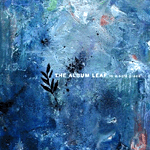While the bumper sticker that reads "Not all who wander are lost" is irritating for the obvious reason that the people who choose to display it are typically new age airheads, it is also irritating due to the sentiment's subtext that, while not lost, those who wander have little to contribute to societal canons and are therefore often in the way. Jimmy LaValle, the brains and brawn behind The Album Leaf, spends a good portion of his albums demonstrating this very principle. Fortunately, on his new album, In a Safe Place, he has plenty of talented musicians to guide him on his path.
Much of the hype surrounding this album stems from the fact that it was recorded at Sigur Rós' studio in Mosfellsbaer, Iceland, and prominently features Sigur Rós members Orri Dýrason and Kjartan Sveinsson (with a couple of notable appearances by Jónsi Birgisson). Also featured are members of Amina (Sigur Rós' string section), Múm, and Pall Jenkins from The Black Heart Procession. With so many contributors to what is ostensibly a solo project, it would be easy for the spirit of Jimmy LaValle to get lost in the hullabaloo, but paradoxically, the songs that best capture the essence of The Album Leaf (as judged by the standard of their live performances) are the ones that feature the most guest performers.
In a Safe Place starts off quite unceremoniously. As the first song, "Window," meanders by, it is quite possible to forget that the album is even playing; when "Thule" starts and the drums kick in, the ensuing journey through a collection of songs as cool and stark as Iceland itself is announced with enough authority to drive "Window" completely from memory. From there it is only a short time before the blue tones of the Rhodes piano succeed in lulling the listener into an emotional fetal position, continually longing for the warmth hidden under the many layers of strings and bells to melt the icy façade.
Unfortunately, after a couple of listens, much of the album starts to sound the same. And while it is ultimately an undeniably listenable album, it is rarely compelling. The notable exception is "Over the Pond," which features Jónsi's (now famous) haunting hopelandic vocals over a landscape of strings, guitar, glockenspiel, keyboards, and plenty of ambient noise. This is the one song that demands the listener's full attention, that embodies the depth of the album's cover, that calls out from a safe place, coaxing you to follow. It is at once both calming and urgent, assuring you that if you just take to heart the message contained in Jónsi's gibberish, everything will be okay.
The main draw to In a Safe Place is that it doesn't need to resort to experimentation or abrasion to distance itself from the rest of the independent music scene. While it may not achieve innovation, it still maintains an air of individuality.
